
You’re welcome to send your Live Wire news tips or suggestions to [email protected].
Today’s Live Wire: Quick Links
- Red Lobster, Olive Garden Open March 7
- Florida Schools Get B- From Education Week
- Another Oil Leak
- Arizona’s Gun Culture
- Epidemic of Homelessness in C. Florida
- Attention Librarians: Newbery Awarded
- The Top 10 Greatest Composers
- Hardison Special: Joseph Brodsky
- A Few Good Links
![]()
Live Wire Rewinds
![]()
Red Lobster and Olive Garden Open March 7 in Palm Coast
It’s the news many–disturbingly many–people have been waiting for: Red Lobster and Olive Garden, the two chain restaurants slowly rising in the Target shopping center in Palm Coast, are set to open March 7. GoToby has the fulls story.
Florida Schools Get B- From Education Week
Education Week produced its annual “Quality Counts” ratings and rankings. No state did well: not a single A, not a single A-. The average in the United States is a C, as befits a nation that pent nearly a decade being led by a C student. South Dakota and Nebraska got Ds. New York and Massachusetts got straight Bs. Florida? B-, but that was enough to rank the state 5th overall. Two factors pushed the state that high: “Standards, Assessments and Accountability,” which got Florida a solid A in that category, and “The teaching profession,” according to Education Week. That category got a solid B in the breakdown. But “school finance,” “chance for success” and “K-12 achievement” all got Cs, and college readiness got a miserable D-, which contradicts and undermines the purpose of accountability and assessment, and points to a weakness in the methodology: if the assessment and standards look good on paper (especially in the paperwork imposed on teachers and administrators) but are dumbed down and calibrated to fit low standards, what’s the point? The fact that the state is dismal in college readiness suggests that its standards are dismal, too. On the other hand, the state also gets an A in early-childhood education. Its overall B- is by the skin of its teeth: it has an 81.5 percent rating.
Here’s the snapshot:
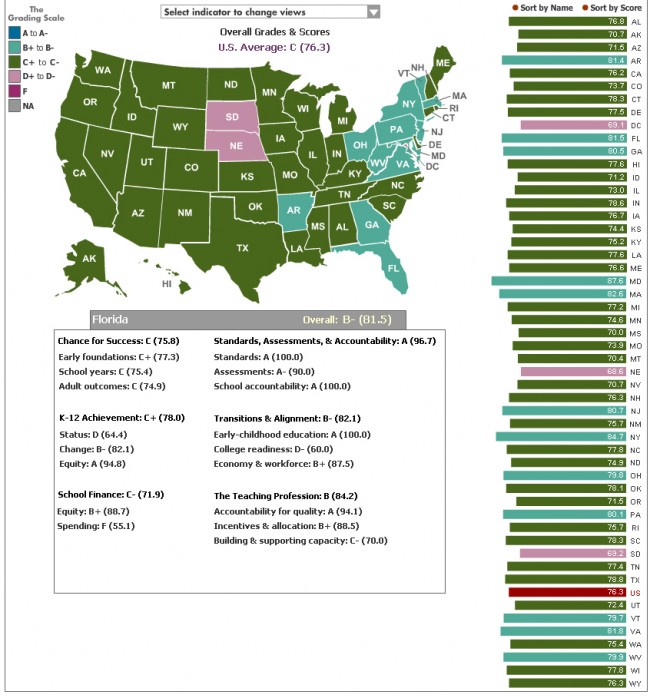
See Also:
- Florida’s High School Students Near Bottom in College Readiness; Flagler’s Do Worse
- FPC Graduate Kristen Hadeed’s Student Maid Co. Tapped for ABC TV’s “Extreme Makeover”
- Ready for Prime Time: Back Home at FPC, IB Conquerors Claim Their Diplomas
- Stetson University and Flagler College Rank Well, Florida Does Not in Higher Ed Survey
Another Oil Leak Shuts Down Alaska Pipeline
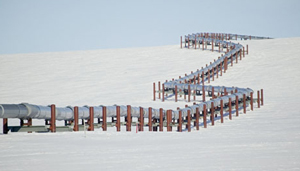 Odd that the matter hasn’t gained more national attention. The country must be tapped out of outrage over oil spills. This one is happening on Alaska’s North Slope. It’s not big by any means (a few dozen barrels) but the consequences are disproportionate. From the Anchorage Daily News: “The shutdown of the trans-Alaska pipeline is likely to extend into a fourth day, making it the third longest closure in the line’s 33-year-history. Officials haven’t yet announced how or when they intend to restart it, which is challenging in the dead of winter. About 600,000 barrels of crude oil — some $50 million worth — that normally would pulse into the pipeline remain in the ground every day it is shut down. North Slope oil field operators are producing only about 5 percent of their usual amount, or about 30,000 barrels a day.
Odd that the matter hasn’t gained more national attention. The country must be tapped out of outrage over oil spills. This one is happening on Alaska’s North Slope. It’s not big by any means (a few dozen barrels) but the consequences are disproportionate. From the Anchorage Daily News: “The shutdown of the trans-Alaska pipeline is likely to extend into a fourth day, making it the third longest closure in the line’s 33-year-history. Officials haven’t yet announced how or when they intend to restart it, which is challenging in the dead of winter. About 600,000 barrels of crude oil — some $50 million worth — that normally would pulse into the pipeline remain in the ground every day it is shut down. North Slope oil field operators are producing only about 5 percent of their usual amount, or about 30,000 barrels a day.
Every day of the shutdown costs the state of Alaska $18.1 million in oil royalties and taxes at current oil prices, according to the state Department of Revenue. That’s money it won’t be able to collect this budget year, although eventually, when all the oil is pumped from the ground, the state presumably will get its share. Oil proceeds are the main source of state revenue. Alyeska Pipeline Service Co., which operates the 800-mile-long pipeline on behalf of oil producers, cut off the flow of oil just before 9 a.m. Saturday after workers discovered crude leaking from a secondary line into the basement of a building at Pump Station 1 on the North Slope. The underground piping system is mainly encased in concrete, but oil flowed into the basement at the point the pipe passes through a wall. As of 10 a.m. Monday, 18 barrels of oil — or 750 gallons — had been recovered from the pump house basement, about double the total as of the day before. Residual oil in the piping or spill path is continuing to seep into the building, the state Department of Environmental Conservation said in a situation report released Monday evening. The cold weather makes restarting the pipeline a challenge. Oil still in the pipeline is cooling. There are risks that ice could form and wax could build up, causing new ruptures, according to state, federal and Alyeska officials. As of Monday evening, federal and state regulators had not yet signed off on a plan to resume the flow of oil.” The full story.
See Also:
- 100,000 Barrels Per Day? The Internal Document that Contradicts BP’s Claims on Oil Flow
- BP Texas Refinery Spewed Tons of Toxic Chemicals for 40 Days Just Before Gulf Blowout
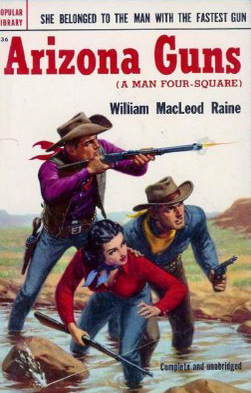 From the Arizona Republic: Arizona’s relationship with guns goes back a long way, to the days of the cowboy’s six-gun, the shoot-out at the OK Corral and the Wild West. While those iconic images have faded into history, Arizona’s gun culture remains alive and well. This is a state, after all, where for many the Second Amendment is near sacrosanct, where driving into the desert to fire guns is a common past-time, and where it recently became legal to carry guns into bars and to carry concealed weapons without a permit. The state’s love affair with guns came under new and intense scrutiny Saturday after a gunman began spraying bullets outside a Tucson-area supermarket, killing six people including a 9-year-old girl and a federal judge, and wounding 14 others, among them U.S. Rep. Gabrielle Giffords, who was shot through the head. […] It is a state with some of the least restrictive gun laws in the country, and a state which, not long before Saturday’s massacre, saw new laws allowing people to carry guns into bars and carry concealed weapons without a permit. […] During her first year in office in 2009, Gov. Jan Brewer signed a bill allowing loaded guns in bars and restaurants, as well as another that prohibits property owners from banning guns from parking areas, so long as the weapons are kept locked in vehicles. And in July, Arizona became the only state in the nation with a large urban population to allow U.S. citizens 21 and older to carry a concealed weapon without a permit. Only the rural states of Alaska and Vermont have similar allowances.” The full story.
From the Arizona Republic: Arizona’s relationship with guns goes back a long way, to the days of the cowboy’s six-gun, the shoot-out at the OK Corral and the Wild West. While those iconic images have faded into history, Arizona’s gun culture remains alive and well. This is a state, after all, where for many the Second Amendment is near sacrosanct, where driving into the desert to fire guns is a common past-time, and where it recently became legal to carry guns into bars and to carry concealed weapons without a permit. The state’s love affair with guns came under new and intense scrutiny Saturday after a gunman began spraying bullets outside a Tucson-area supermarket, killing six people including a 9-year-old girl and a federal judge, and wounding 14 others, among them U.S. Rep. Gabrielle Giffords, who was shot through the head. […] It is a state with some of the least restrictive gun laws in the country, and a state which, not long before Saturday’s massacre, saw new laws allowing people to carry guns into bars and carry concealed weapons without a permit. […] During her first year in office in 2009, Gov. Jan Brewer signed a bill allowing loaded guns in bars and restaurants, as well as another that prohibits property owners from banning guns from parking areas, so long as the weapons are kept locked in vehicles. And in July, Arizona became the only state in the nation with a large urban population to allow U.S. citizens 21 and older to carry a concealed weapon without a permit. Only the rural states of Alaska and Vermont have similar allowances.” The full story.
See Also:
- Our permanent culture of political violence
Epidemic of Homelessness in C. Florida
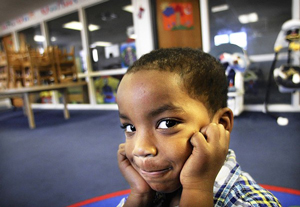 From the Sentinel: “Since the recession began in late 2007, the number of homeless children attending public schools in Orange, Osceola and Seminole counties has more than tripled — from 1,300 to more than 4,200. And while reliable figures for homeless adults with children are not yet available, recent changes in the way the federal government conducts its homeless census should reveal an accurate picture of the problem sometime this spring. Meanwhile, nonprofit agencies that shelter families report that they have been overwhelmed by the demand, with most operating at or near capacity these days. Sometimes, even, the shelters have to turn away women and children who have nowhere else to go. What’s especially tragic, said Cathy Jackson, executive director of the Homeless Services Network of Central Florida, is the effect on children. Studies have shown that the chaotic nature of homelessness often has long-term consequences on development and opportunity for kids. “It’s not just the phenomenon of people living in hotels and struggling,” Jackson said. “We’re talking about thousands of children impacted academically and emotionally — and for a long time. Our society is going to pay for this for years to come.” […] In Orange County, for instance, there are only 718 beds for the homeless — about 62 percent of what officials say is necessary to meet demand. In Seminole, the number drops to 184 beds or 46 percent of what’s needed. And in Osceola, there are 115 beds, barely 20 percent of what’s needed. “Homelessness is an epidemic now,” said Ernest Hamilton, executive director of the Rescue Outreach Mission in Sanford. “As soon as you expand, you’re full again, and you’ve probably got a waiting list.” The full story.
From the Sentinel: “Since the recession began in late 2007, the number of homeless children attending public schools in Orange, Osceola and Seminole counties has more than tripled — from 1,300 to more than 4,200. And while reliable figures for homeless adults with children are not yet available, recent changes in the way the federal government conducts its homeless census should reveal an accurate picture of the problem sometime this spring. Meanwhile, nonprofit agencies that shelter families report that they have been overwhelmed by the demand, with most operating at or near capacity these days. Sometimes, even, the shelters have to turn away women and children who have nowhere else to go. What’s especially tragic, said Cathy Jackson, executive director of the Homeless Services Network of Central Florida, is the effect on children. Studies have shown that the chaotic nature of homelessness often has long-term consequences on development and opportunity for kids. “It’s not just the phenomenon of people living in hotels and struggling,” Jackson said. “We’re talking about thousands of children impacted academically and emotionally — and for a long time. Our society is going to pay for this for years to come.” […] In Orange County, for instance, there are only 718 beds for the homeless — about 62 percent of what officials say is necessary to meet demand. In Seminole, the number drops to 184 beds or 46 percent of what’s needed. And in Osceola, there are 115 beds, barely 20 percent of what’s needed. “Homelessness is an epidemic now,” said Ernest Hamilton, executive director of the Rescue Outreach Mission in Sanford. “As soon as you expand, you’re full again, and you’ve probably got a waiting list.” The full story.
See Also:
- To Be Homeless in Flagler
- Calvary Christian’s Bus Ministry: Treasuring the Homeless, One Sunday at a Time
- A Bench, a Homeless Man, A Cop’s Brutal Judgment: Poverty as a Presumption of Guilt
Newberry Medla, the Children’s Books Honor, Awarded to Clare Vanderpool
 From Newberry: “The 2011 Newbery Medal winner is Moon over Manifest by Clare Vanderpool, published by Delacorte Press, an imprint of Random House Children’s Books, a division of Random House, Inc. The town of Manifest is based on Frontenac, Kan., the home of debut author Clare Vanderpool’s maternal grandparents. Vanderpool was inspired to write about what the idea of “home” might look like to a girl who had grown up riding the rails. She lives in Wichita with her husband and four children. “Vanderpool illustrates the importance of stories as a way for children to understand the past, inform the present and provide hope for the future,” said Newbery Medal Committee Chair Cynthia K. Richey.”
From Newberry: “The 2011 Newbery Medal winner is Moon over Manifest by Clare Vanderpool, published by Delacorte Press, an imprint of Random House Children’s Books, a division of Random House, Inc. The town of Manifest is based on Frontenac, Kan., the home of debut author Clare Vanderpool’s maternal grandparents. Vanderpool was inspired to write about what the idea of “home” might look like to a girl who had grown up riding the rails. She lives in Wichita with her husband and four children. “Vanderpool illustrates the importance of stories as a way for children to understand the past, inform the present and provide hope for the future,” said Newbery Medal Committee Chair Cynthia K. Richey.”
Newbery Honor Books of 2011:
Turtle in Paradise by Jennifer L. Holm, published by Random House Children’s Books, a div. of Random House, Inc. Sassy eleven-year-old Turtle finds her life turned on end when she is sent to live with her aunt in Depression-era Key West. With vivid details, witty dialogue and outrageous escapades, Jennifer Holm successfully explores the meaning of family and home… and lost treasures found.
Heart of a Samurai by Margi Preus, published by Amulet Books, an imprint of Abrams. Shipwrecks, whaling, a search for home and a delightful exploration of cultures create a swashbuckling adventure. This historical novel is based on the true story of Manjiro (later John Mung), the young fisherman believed to be the first Japanese person to visit America, who against all odds, becomes a samurai.
Dark Emperor and Other Poems of the Night by Joyce Sidman, illustrated by Rick Allen, published by Houghton Mifflin Books for Children, Houghton Mifflin Harcourt. Welcoming her readers into the “wild, enchanted park” that is the night, Joyce Sidman has elegantly crafted twelve poems rich in content and varied in format. Companion prose pieces about nocturnal flora and fauna are as tuneful and graceful as the poems. This collection is “a feast of sound and spark.”
One Crazy Summer by Rita Williams-Garcia, published by Amistad, an imprint of HarperCollins Publishers. The voices of sisters Delphine, Vonetta and Fern sing in three-part harmony in this wonderfully nuanced, humorous novel set in 1968 Oakland, Calif. One crazy summer, the three girls find adventure when they are sent to meet their estranged poet-mother Cecile, who prints flyers for the Black Panthers.
The Caldecot Medal was also awarded. It went to A Sick Day for Amos McGee, illustrated by Erin E. Stead, written by Philip C. Stead. A Neal Porter Book, published by Roaring Brook Press, a division of Holtzbrinck Publishing. In this tender tale of reciprocity and friendship, zookeeper Amos McGee gets the sniffles and receives a surprise visit from his caring animal friends. Erin Stead’s delicate woodblock prints and fine pencil work complement Philip Stead’s understated, spare and humorous text to create a well-paced, gentle and satisfying book, perfect for sharing with friends. “Endearing, expressive characterization in spare illustrations rendered in muted tones distinguish this timeless picture book. It’s a great day for Amos McGee!” said Caldecott Medal Committee Chair Judy Zuckerman.
See Also:
- Newbery Medal Website
- Newbery Medal and Honor Books, 1922-Present
- Past Caldecot Medal Winners, 1938-Present
The Top 10 Composers of All Time
The Times’ Anthony Tommasini has a challenge: “You know that a new year has truly arrived when critics stop issuing all those lists of the best films, books, plays, recordings and whatever of the year gone by. These lists seem to be popular with readers, and they stir up lively reactions. Like other critics I enjoy recalling the pieces and performances that struck me as exceptionally good, or exceptionally bad, during the year in classical music. Yet in other fields, critics and insiders think bigger. Film institutes periodically issue lists of the greatest films of all time. (“Citizen Kane” seems to have a lock on the top spot.) Rock magazines routinely tally the greatest albums ever. And think of professional tennis, with its system of rankings, telling you exactly which player is No. 1 in the world, or 3, or 59. Imagine if we could do the same in classical music, if there were ways to rank pianists, sopranos and, especially, composers. The Top 10 composers of all time. Now that’s the list I have secretly wanted to compile. It would be absurd, of course, but fascinating. Hold on here. I don’t do ranking. As I see it, the critic’s job description does not include compiling lists of greats in order of greatness. What I do is champion, demystify and describe the composers, works and artists I admire, and, as appropriate, puncture inflated reputations. […] So if you were to try to compile a list of the 10 greatest composers in history, how would you go about it? For me the resulting list would not be the point. But the process of coming up with such a list might be clarifying and instructive, as well as exasperating and fun. […] I am focusing on Western classical music. There are compelling arguments against honoring this classification. Still, giants like George Gershwin, Duke Ellington and Stephen Sondheim are outside my purview here. And on the assumption that we are too close to living composers to assess their place and their impact, I am eliminating them from consideration. […] So to get things going, let’s start with an easy one: Bach. He would probably be the consensus choice among thinking musicians for the top spot. But why?” See the full story, and watch Tommasini:
See Also:
Hardison Special: Joseph Brodsky
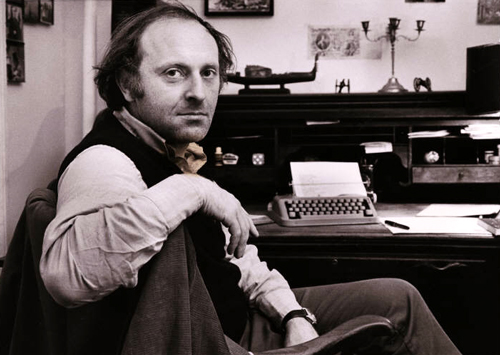
A List of Some Observations
A list of some observation. In a corner, it’s warm.
A glance leaves an imprint on anything it’s dwelt on.
Water is glass’s most public form.
Man is more frightening than its skeleton.
A nowhere winter evening with wine. A black
porch resists an osier’s stiff assaults.
Fixed on an elbow, the body bulks
like a glacier’s debris, a moraine of sorts.
A millennium hence, they’ll no doubt expose
a fossil bivalve propped behind this gauze
cloth, with the print of lips under the print of fringe, mumbling “Good night” to a window hinge.
–Joseph Brodsky
And this wonderful and not so wonderfully contemptuous passage about Istanbul from one of his Brodsky’s great essays, “Flight from Byzantium” (he had his issues): “The delirium and horror of the East. The dusty catastrophe of Asia. Green only on the banner of the Prophet. Nothing grows here except mustaches. A black-eyed, overgrown-with-stubble-before-supper part of the world. Bonfire embers doused with urine. That smell! A mixture of foul tobacco and sweaty soap and the underthings wrapped around loins like another turban. Racism? But isn’t it only a form of misanthropy? And that ubiquitous grit flying in your muzzle even in the city, poking the world out of your eyes—and yet one feels grateful even for that. Ubiquitous concrete, with the texture of turd and the color of an upturned grave. Ah, all that nearsighted scum—Corbusier, Mondrian, Gropius—who mutilated the world more effectively than any Luftwaffe! Snobbery? But it’s only a form of despair. The local population in a state of total stupor whiling its time away in squalid snack bars, tilting its heads as in a namaz in reverse toward the television screen, where somebody is permanently beating somebody else up. Or else they’re dealing out cards, whose jacks and nines are the sole accessible abstraction, the single means of concentration. Misanthropy? Despair? Yet what else could be expected from one who has outlived the apotheosis of the linear principle? From a man who has nowhere to go back to? From a great turdologist, sacrophage, and the possible author of Sadomachia?”
See Also:
- Netanyahu, king of spin
- Rude Pundit: Dear Right-Wingers: You Are All Muslims Now
- A Horrid Crime, a Dishonest Debate
- Consumer confidence unchanged among Floridians in December




























Inna Hardison says
Pierre – maybe it’s the narcissist in me that keeps clicking on things with my name on them, but… you’ve no idea how much I needed this diversion (albeit that word is rather remiss with respect to Brodsky). So thank you!